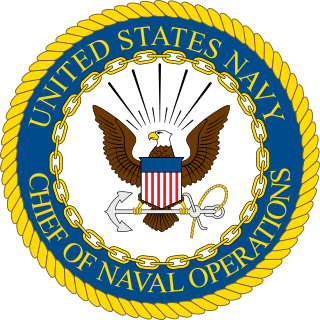
The chief of naval operations (CNO) is the highest-ranking officer of the United States Navy. The position is a statutory office held by an admiral who is a military adviser and deputy to the secretary of the Navy. The CNO is also a member of the Joint Chiefs of Staff and in this capacity, a military adviser to the National Security Council, the Homeland Security Council, the secretary of defense, and the president.

Franklin Delano Roosevelt, commonly known by his initials FDR, was an American politician who served as the 32nd president of the United States from 1933 until his death in 1945. The longest serving U.S. president, he is the only president to have served more than two terms. His initial two terms were centered on combating the Great Depression, while his third and fourth saw him shift his focus to America's involvement in World War II.

The National Security Act of 1947 was a law enacting major restructuring of the United States government's military and intelligence agencies following World War II. The majority of the provisions of the act took effect on September 18, 1947, the day after the Senate confirmed James Forrestal as the first secretary of defense.

The Portsmouth Naval Shipyard, often called the Portsmouth Navy Yard, is a United States Navy shipyard on Seavey's Island in Kittery, Maine, bordering Portsmouth, New Hampshire. The naval yard lies along the southern boundary of Maine on the Piscataqua River.

The United States Department of War, also called the War Department, was the United States Cabinet department originally responsible for the operation and maintenance of the United States Army, also bearing responsibility for naval affairs until the establishment of the Navy Department in 1798, and for most land-based air forces until the creation of the Department of the Air Force on September 18, 1947.

Josephus Daniels was an American diplomat and newspaper editor from the 1880s until his death, who managed The News & Observer in Raleigh, at the time North Carolina's largest circulation newspaper, for decades. A Democrat, he was appointed by President Woodrow Wilson to serve as Secretary of the Navy during World War I. He became a close friend and supporter of Franklin D. Roosevelt, then Assistant Secretary of the Navy. After Roosevelt was elected President of the United States, he appointed Daniels as his U.S. Ambassador to Mexico, serving from 1933 to 1941. Daniels was a vehement white supremacist and segregationist. Along with Charles Brantley Aycock and Furnifold McLendel Simmons, he was a leading perpetrator of the Wilmington insurrection of 1898.
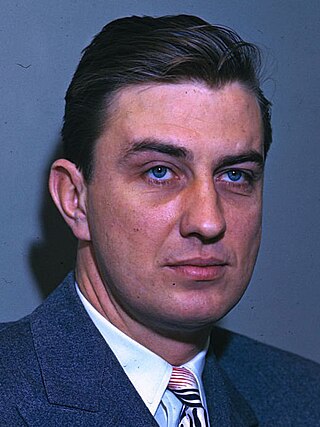
Franklin Delano Roosevelt Jr. was an American lawyer, politician, and businessman. He served as a United States congressman from New York from 1949 to 1955 and in 1963 was appointed United States Under Secretary of Commerce by President John F. Kennedy. He was appointed as the first chairman of the Equal Employment Opportunity Commission from 1965 to 1966 by President Lyndon B. Johnson. Roosevelt also ran for governor of New York twice. He was a son of President Franklin D. Roosevelt and First Lady Eleanor Roosevelt, and served as an officer in the United States Navy during World War II.

The Washington Navy Yard (WNY) is a ceremonial and administrative center for the United States Navy, located in Washington, D.C. It is the oldest shore establishment of the U.S. Navy, situated along the Anacostia River in the Navy Yard neighborhood of Southeast D.C.

William Franklin Knox was an American politician, soldier, newspaper editor, and publisher. He was the Republican vice presidential candidate in 1936 and Secretary of the Navy under Franklin D. Roosevelt during most of World War II. On December 7, 1941, Knox, flanked by his assistant John O’Keefe, walked into Roosevelt's White House study around 1:30 pm EST, and announced that Japan had attacked Pearl Harbor.

The Judge Advocate General's Corps, also known as the "JAG Corps" or "JAG", is the legal arm of the United States Navy. Today, the corps consists of a worldwide organization of more than 730 commissioned officers serving as judge advocates, 30 limited duty officers (law), 500 enlisted members and nearly 275 civilian personnel, all serving under the direction of the Judge Advocate General of the Navy.
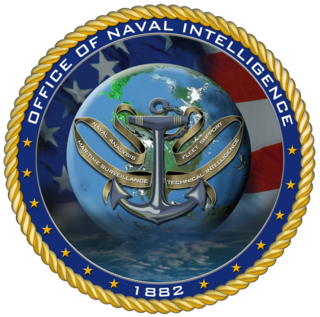
The Office of Naval Intelligence (ONI) is the military intelligence agency of the United States Navy. Established in 1882 primarily to advance the Navy's modernization efforts, it is the oldest member of the U.S. Intelligence Community and serves as the nation's premier source of maritime intelligence.
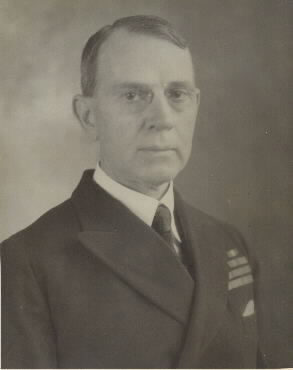
Commodore Dudley Wright Knox was an officer in the United States Navy during the Spanish–American War and World War I. He was also a prominent naval historian, who for many years oversaw the Navy Department's historical office, now named the Naval History and Heritage Command.
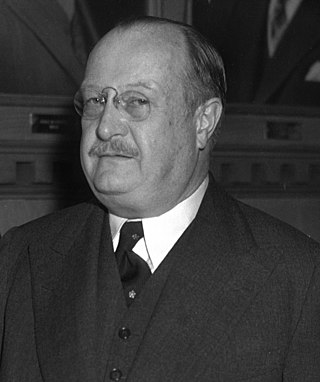
Henry Latrobe Roosevelt was an Assistant Secretary of the United States Navy and a member of the Roosevelt family.

The Assistant Secretary of the Navy (AIR) was a civilian office of the United States Department of the Navy. The Assistant Secretary of the Navy (AIR) initially reported to the Assistant Secretary of the Navy and later to the Under Secretary of the Navy.
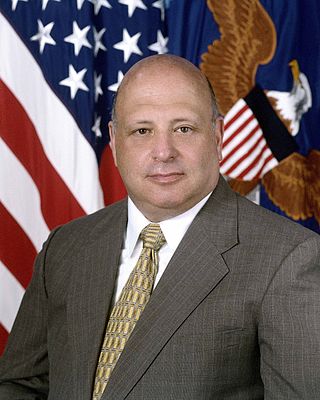
Bernard Daniel Rostker was Principal Deputy Assistant Secretary of the Navy from 1977 to 1979; Director of the United States Selective Service System from 1979 to 1981; Assistant Secretary of the Navy from 1994 to 1998; Under Secretary of the Army from 1998 to 2000; and Under Secretary of Defense for Personnel and Readiness in 2000–2001. From 1996 to 2001, he also served as Special Assistant to the Deputy Secretary of Defense for Gulf War Illnesses.

Ralph Austin Bard was a Chicago financier who served as Assistant Secretary of the Navy, 1941–1944, and as Under Secretary, 1944–1945. He is noted for a memorandum he wrote to Secretary of War Henry L. Stimson in 1945 urging that Japan be given a warning before the use of the atomic bomb on a strategic city. He was "the only person known to have formally dissented from the use of the atomic bomb without advance warning."

The United States Department of Defense (DoD) has a complex organizational structure. It includes the Army, Navy, the Marine Corps, Air Force, Space Force, the Unified combatant commands, U.S. elements of multinational commands, as well as non-combat agencies such as the Defense Intelligence Agency and the National Security Agency. The DoD's annual budget was roughly US$496.1 billion in 2015. This figure is the base amount and does not include the $64.3 billion spent on "War/Non-War Supplementals". Including those items brings the total to $560.6 billion for 2015.
The presidency of Franklin D. Roosevelt began on March 4, 1933.

The third presidential term of Franklin D. Roosevelt began on January 20, 1941, when he was once again inaugurated as the 32nd president of the United States, and the fourth term of his presidency ended with his death on April 12, 1945. Roosevelt won a third term by defeating Republican nominee Wendell Willkie in the 1940 United States presidential election. He remains the only president to serve for more than two terms. Unlike his first two terms, Roosevelt's third and fourth terms were dominated by foreign policy concerns, as the United States became involved in World War II in December 1941.
















































